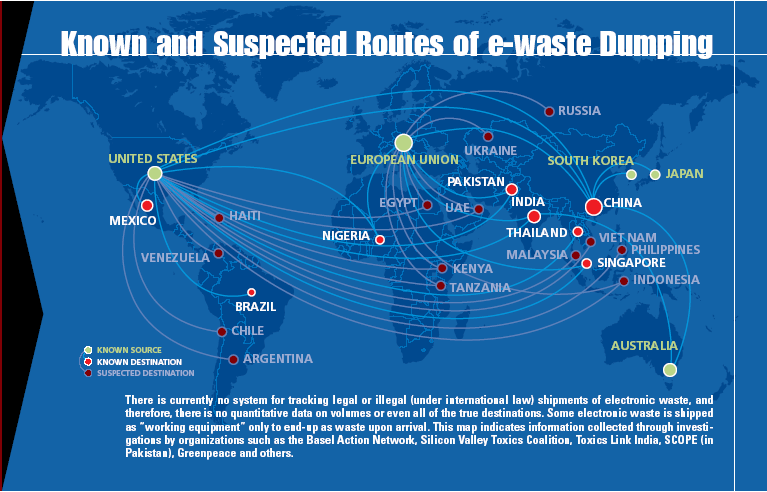Illegal Flows
Developing countries are still the primary recipient of illegally exported e-waste from the developed world. Although these activities have been banned under the United Nations Basel Convention and written into legislation in the EU and OECD since the early 1990s, e-waste continues to be exported from areas such as North America, Europe and Australia. A 2002 study completed by BAN (Basel Action Network), a watchdog organisation based in the United States, reported that 80% of the e-waste sent to local recyclers was not processed domestically but was being diverted offshore. This translated to 10.2 million units per year. BAN reported that in 2003, 160,000 tonnes of e-waste were exported from the UK.
The e-waste challenge in developing countries, from both local consumption and illegal dumping, is exacerbated by limited legislation, plus the lack of available enforcement and regulatory resources to curb illegal transport on an international level. Additionally, these regions often lack the specialised infrastructure and expertise necessary for proper e-waste handling.
The Basel Convention
The Basel Convention came about in response to a number of international incidents related to the disposal of hazardous waste and was the first global and most recognized initiative to address the international e-waste flow. It was drafted in 1989 and in 1992 the The United Nations Basel Convention on the Control of Transboundary Movement of Hazardous Waste and Their Disposal was internationally adopted. The initial goal of the treaty was to develop a framework to control the cross-border or “transboundary” movement of hazardous waste and to identify and define what an environmentally sound management system (ESM) would look like for hazardous waste. ESM is an integrated life-cycle approach to hazardous waste that looks at the production (cradle) then storage, transport and disposal (grave) of goods. Under the Basel Convention, transboundary movement can only occur with prior written consent granted by the importing country’s authorities. Shipments made without the necessary documentation would be considered illegal.
After implementation weakness were identified, including:
- Lack of an enforcement model or mediation entity to handle international disputes regarding the export and import of e-Waste
- Limited guidance to ensure that the approved vessels for transport were only carrying items approved in the Basel Convention and by the importing countries.
In 1994 the Basel Ban Amendment was introduced as a revision to the Convention to address these weakness, extending the treaty’s scope from transport and disposal to banning the transboundary movement of material classified as hazardous from OECD countries to non-OECD countries. The transport of hazardous waste for disposal was immediately banned.
In 1992, the OECD adopted the Basel Convention and later the Basel Ban Amendment, thus a requirement has been made that all OECD member countries are expected to implement the requirements set out by the treaty into their national policies. In adopting the Basel Convention, the OECD members are also mandated to agree with the classifications of e-waste that are documented by the Basel Convention and to prohibit the export of e-waste to non-OECD countries.
As a further extension of the jurisdiction of the Basel Convention and Basel Ban Amendment, the European Commission (EC) has required that all EU Member States ratify the Basel Convention. Most are members of the OECD and are already required to abide by this regulation; however the EU adoption extends compliance to five non-OECD member countries. At this time, the Basel Ban has been transposed into law by the EU under the WEEE Directive.
SOURCE: BASEL ACTION NETWORK; UNITED NATIONS ENVIRONMENTAL PROGRAMME


